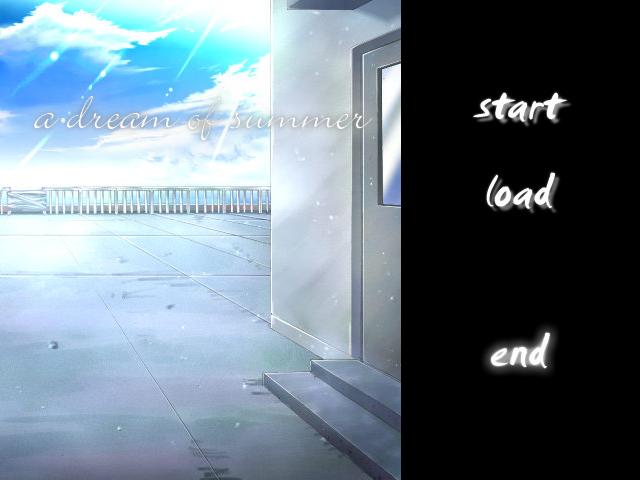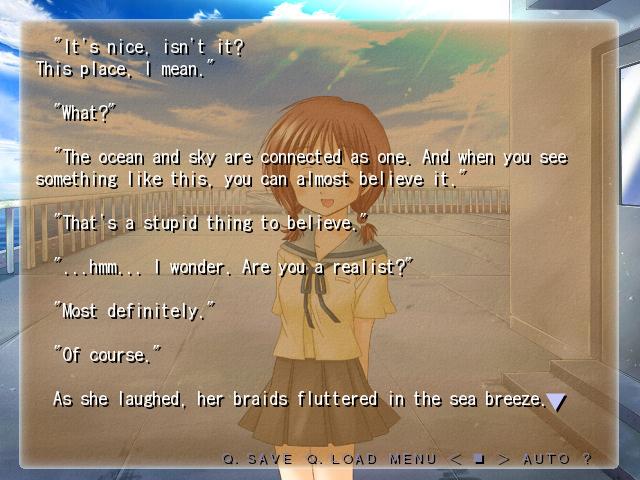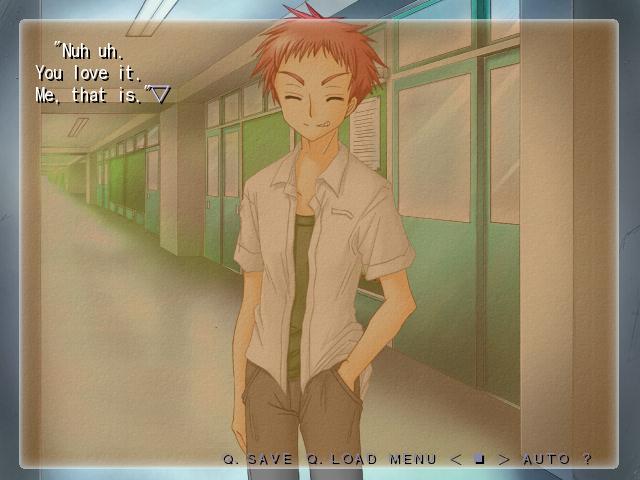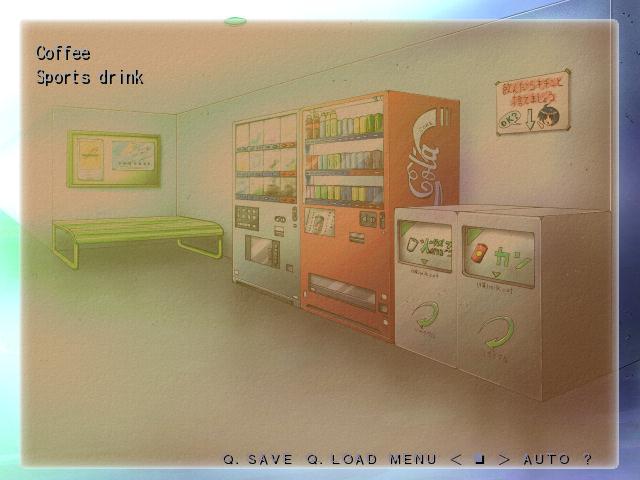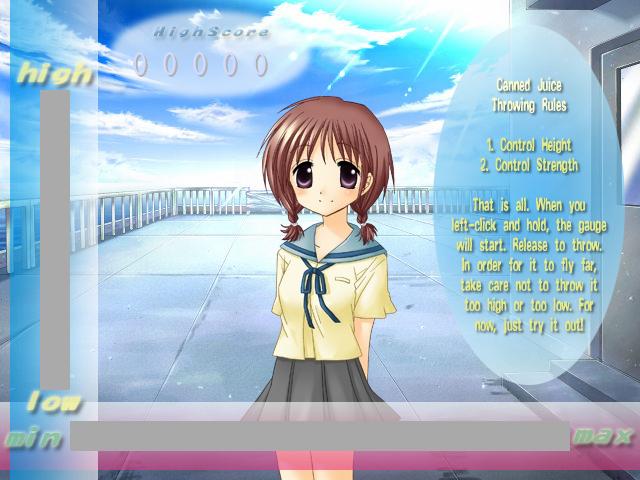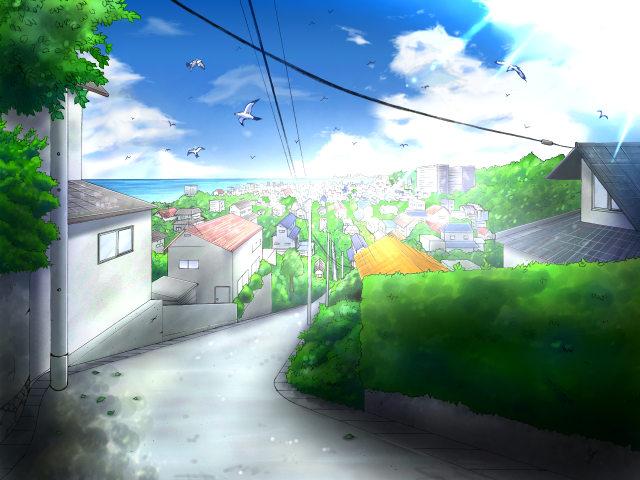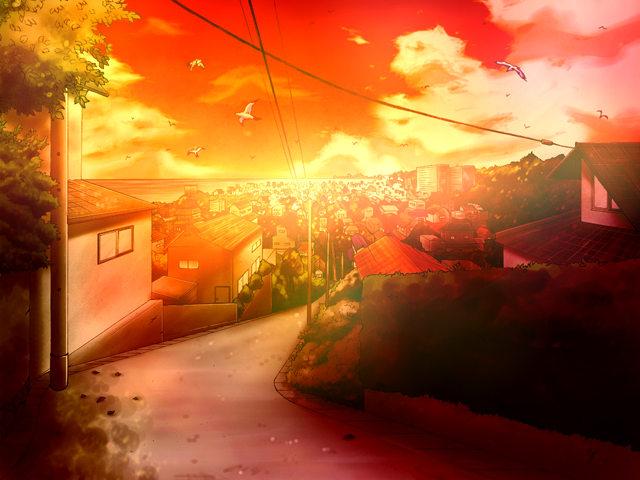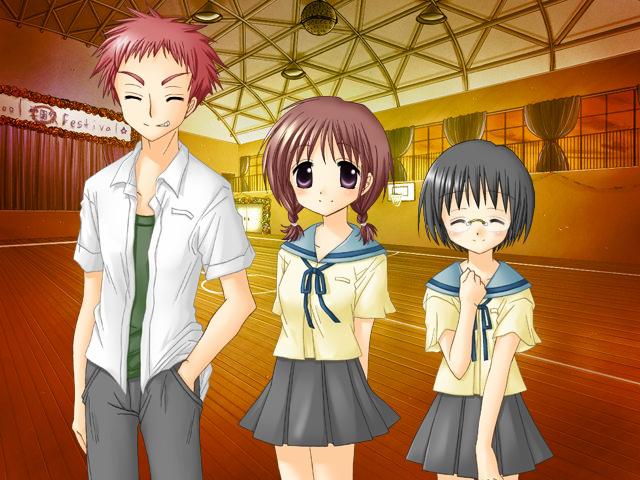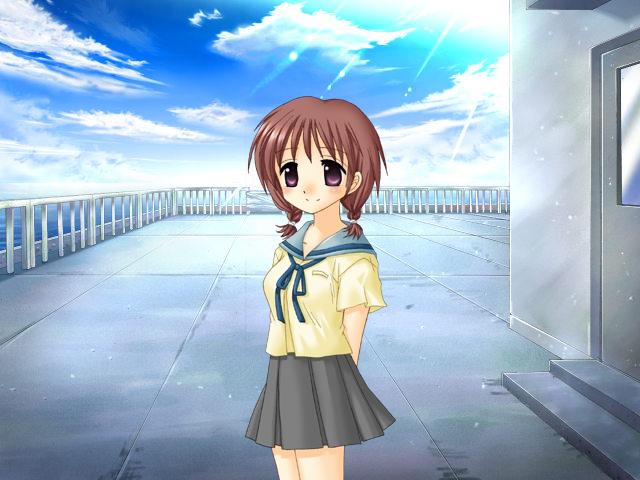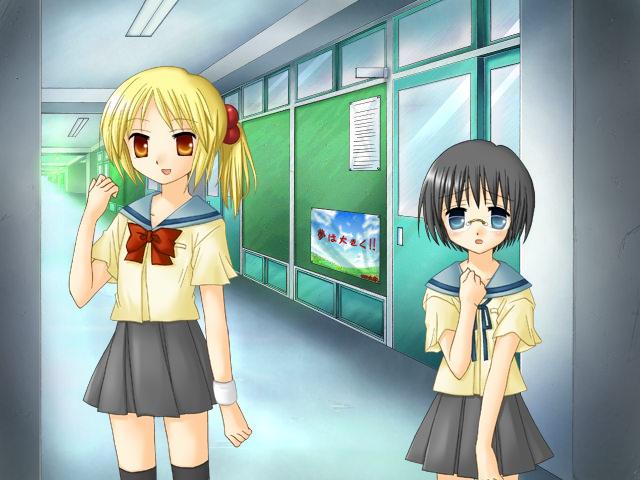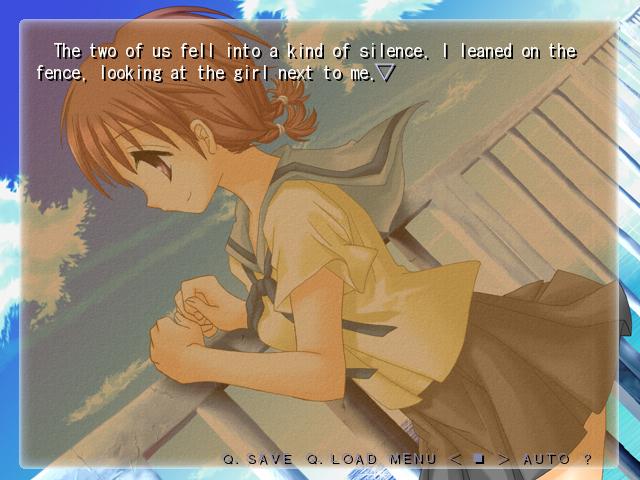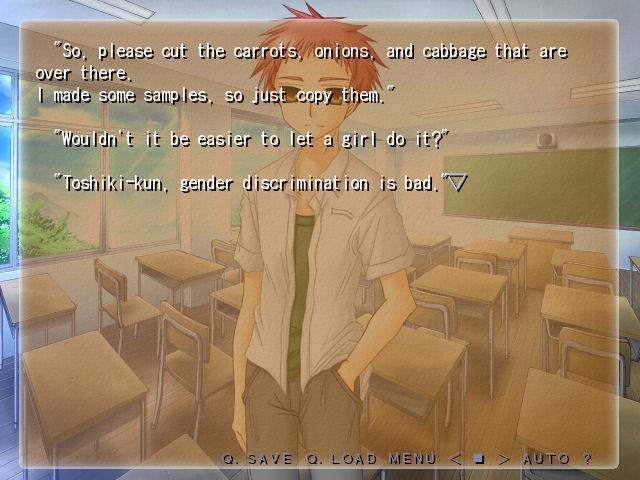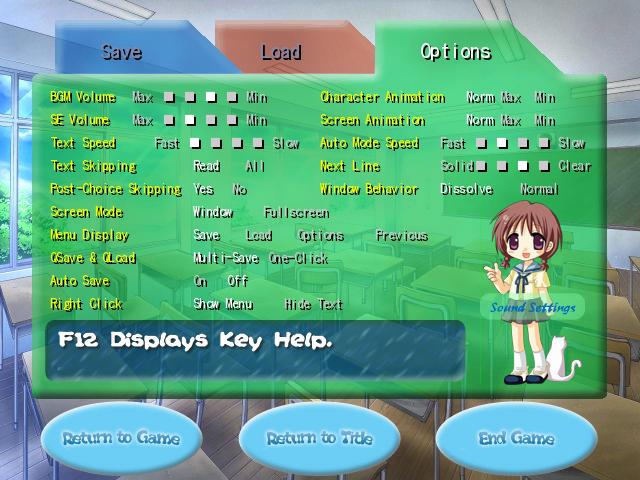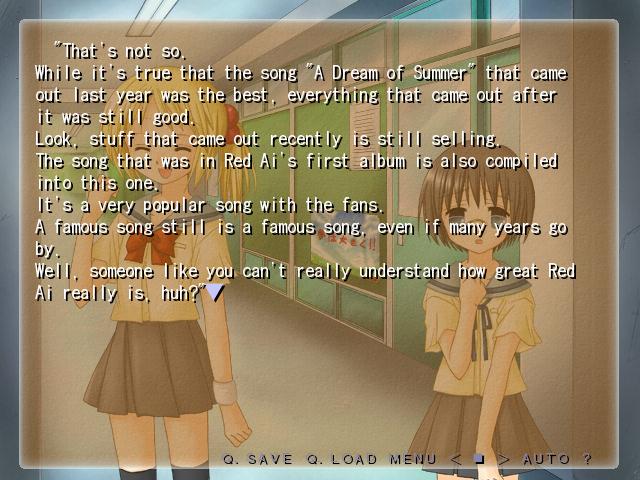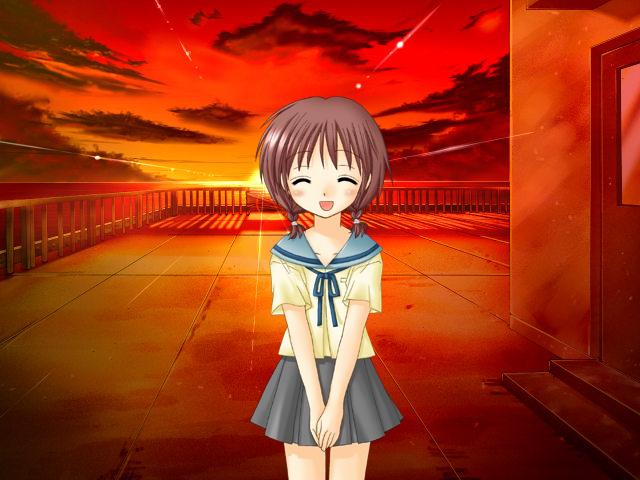A Dream of Summer is the official 2006 translation of a 2005 freeware Japanese visual novel titled Hitonatsu no Yume. The original Japanese novel was created by milkcat, who, unlike most developers of al|together novels, is still active, having just released a new game in 2022. The English translation was completed by circle DejaVu, a prolific translation circle in the latter half of the 2000s, and submitted to the al|together 2006 translation festival. I am reviewing A Dream of Summer as part of my project to review almost all of the 31 Japanese visual novels translated into English and contributed to the 2005, 2006, and 2008 al|together translation festivals. This is my 26th review of the project.
You can learn more about my al|together project by reading my project introduction article. That article includes a running list of our completed al|together reviews. I have a dedicated collection post with links to all of our al|together articles, including reviews, essays, and short posts.
A Dream of Summer is one of the longer al|together visual novels, featuring more than one hour of reading time and branching paths based on a small number of choices. The narrator and (almost) sole view-point character is Toshiki Sugai, a somewhat disaffected high school senior described by his few friends as a realist. The novel takes place over the course of three days in July wherein the school is preparing for, and then partaking in, a cultural festival. Toshiki vaguely remembers a promise he made to a girl long ago. He meets a girl he has never seen before and makes memories with his friends in a school band called BROY.
Non-spoiler note
As always, I will endeavor to write a spoiler-free review such that people who want to read A Dream of Summer can read my review first without having the plot and twists revealed, and people who have already read the novel can understand my final assessment of the novel with added perspective. A Dream of Summer is interesting in that it implicitly shows its hand very early and explicitly makes the main twists clear just a bit past the half-way point, but I will still work to refrain from discussing the nature of these twists with undue specificity. Of course, if you are 100% certain that you will read A Dream of Summer, I recommend doing so before reading my review.
A Dream of Summer Details
Visual Novel Database Entry Link.
English Translation:
| Title | A Dream of Summer |
| Translator | DejaVu (archived) |
| Release Date | August 2006 |
| Engine | ONScripter-EN |
| Official Website | al|together 2006; archived DejaVu page |
As I noted in the introduction, DejaVu was a prolific translation circle, albeit A Dream of Summer was its only al|together contribution. While the circle’s original website is no longer online (see archived), their subsequent translations remain available and I look forward to reviewing some of them outside the scope of the al|together project.
Original Japanese novel:
| Title | Hitonatsu no Yume |
| Creator | milkcat |
| Release Date | (Initial) August 6, 2005; (Final) September 6, 2005 |
| Engine | NScripter |
| Website | Developer’s Page |
| Download | Vector; Freem! |
The developer of A Dream of Summer, milkcat, is still active and just recently released a game in 2022. The developer’s first novel, At Summer’s End, was also translated and submitted to al|together 2006, and I reviewed it in December 2022.
Note on alternative releases of A Dream of Summer
The al|together 2006 version of A Dream of Summer was translated from the novel’s original 2005 Japanese release. The Japanese novel, like most of the novels translated for al|together, was written in NScripter. In 2018, developer milkcat re-wrote A Dream of Summer in Tyrano Script and made the new version free to play for web browsers. Better yet, the Tyrano Script version is also playable in English (select English from the start menu):
- Tyrano Script version of A Dream of Summer (official version – free to play online)
Because the purpose of my project is to review the original al|together visual novels, I read the al|together 2006 version of A Dream of Summer instead of the 2018 Tyrano Script re-release. I took a quick look at the new browser version and noted that it appears to use the 2006 DejaVu translation verbatim for the English version, so for purpose of reading the story in English, you can get the same experience with the new re-release. I plan to read through the new browser version at some point in the future and do a comparison similar to what I undertook for the Yuuki!Novel and NScripter versions of Tegami.
I found another interesting note while researching A Dream of Summer. In 2005, milkcat made available a premium version of the novel for a low price (840 yen over the counter, 500 yen for a special promotion) (see link). The commercial version came with a physical CD release of the game, a separate music CD, and higher quality voices and music. The sale began on August 14, 2005. Unfortunately, the sale has long sense been completed – but I would be curious to know if any Japanese readers have seen old copies of the physical novel floating around.
Running A Dream of Summer
Before explaining how I ran A Dream of Summer, I would recommend that people who are interested in just reading the novel should go with milkcat’s revised Tyrano Script version, which is playable in web browsers. My decision to go with the original release was due to the particularities of my al|together review project.
A Dream of Summer remains available to download from three sources:
- altogether 2006 mirror (direct and torrent)
- Kaisernet (direct)
- MEGA (direct)
The original A Dream of Summer can be downloaded for Windows, Linux, and MacOS from a mirror of the original al|together 2006 site. Kaisernet provides a link to the Windows version. The linked MEGA folder contains all of the al|together novels, but it is not necessary for just downloading A Dream of Summer.
I ran A Dream of Summer natively on Linux. Linux users can follow my guides to running ONScripter-EN in the Linux download’s directory (see system install and local binary guides) or extract the Windows executable into a new directory and running the Linux ONScripter-EN in that (see guide). Note that the original Linux executable does not work on my system. I did have one issue particular to A Dream of Summer. ONScripter-EN is currently being developed by Gallidite27 on GitHub, and I generally recommend that Linux (and Windows) users use the newest ONScripter-EN version from there.
August 11, 2024 Update: In my original article, I recommended that linux users use the 2011 build of ONScripter-EN because this novel was not working with the new 2023 releases on my system. I subsequently tested it with the Galladite27’s 07-24-2024 build of ONScripter-EN and it seems to work exactly as expected. Thus, I now recommend using Galladite27’s ONScripter-EN builds to run the al|together A Dream of Summer on Linux (you should go with the newest version, but I can confirm 07-24-2024 seems to work fine.)
Most Windows users should still be able to install A Dream of Summer using the 2006 installer (installed on top of WINE on Linux).
It may run fine on Windows with the original executable, but Windows users who have issues can replace the 2006 ONScripter build with the Gallidite27 or 2011 versions for Windows and see if either of those makes a difference (my Linux directory guide should illustrate how to replace the ONScripter-EN executable on a Windows install – the process is similar and also explained on Kaisernet).
Although there is a MacOS release of A Dream of Summer, it almost certainly does not work on modern Macs with M2 processors (it may work on some older models). MacOS users who want to try to run the original A Dream of Summer can try to run the Windows version on top of WINE (see my guide to PlayOnLinux, which should apply to some extent to PlayOnMac).
General overview of A Dream of Summer
I begin with DejaVu’s description of the novel:
Toshiki, the realist.
Mizuna, the girl he met on the roof.
And BROY, the school band whose members surround them.
It’s the summer of their third year, and Toshiki must face not only the school festival, but also a promise that he may never be able to fulfill.
Having read the novel, I can confirm that this cryptic introduction is accurate. A Dream of Summer is a difficult to introduce without spoilers, but I will give it my best shot.
Toshiki is in his final year of high school on the eve of what will be his last summer school festival. The novel insists on describing him as a realist, but I think that “dry and a bit listless” gives a more accurate impression.
The novel makes clear early through Toshiki’s conversation with his best friend, the comparatively boisterous Reiji Nishihara, that Toshiki is haunted by some promise he made to his first love many years before the start of our story which involved the school festival.
Reiji is in a band called BROY. We soon meet two of his fellow band members, Mami Kagawa and the painfully shy Rin Shinoi, both of whom are friends of Toshiki (more Mami than Rin, although Rin proves to be the more significant character of the pair).
Shortly after that introduction, Toshiki chases a cat onto the school roof where he meets a short girl one year his junior named Mizuna Hazuki. Toshiki and Mizuna quickly take to teasing each other (usually instigated by Toshiki), but get along well.
(Note: I will refer to Mizuna Hazuki and Reiji Nishihara by their first names in this article. I will refer to Rin Shinoi by her last name.)
The game suggests that Mizuna is somehow important to Toshiki with the subtlety of a cultural festival bonfire, and I suspect that most readers will catch on to many of the particulars within the first 10-15 minutes of reading. But because this is a spoiler-free introduction, I will leave the intro by noting that the entire novel takes place over the course of four days in a certain July.
A Dream of Summer Review
Below, I review the different parts that make up A Dream of Summer.
Estimated reading time
It is harder for me to guess the estimated reading time here than usual because for reasons I explained in a 2022 article, I read the first ending of A Dream of Summer back in December 2022 and only returned to refresh my memory and complete the other main ending in September 2023. One reader gave it a 2 hour and 30 minute estimate on Visual Novel Database, but that seems too long to me.
Some of A Dream of Summer’s length depends on how one reads it. It ultimately has two real endings and various ways to reach a truncated bad ending. Considering only the two non-bad endings, the differences in the first half of the novel primarily implicate two scenes. Assuming one takes the quickest path through the novel, I will venture that there is a bit more than an hour of reading, but mileage will vary depending on how fast one reads and how one makes use of the skip functionality. Some additional time could be added for wrong choice combinations – although as I explain below, the choice structure is relatively simple.
Game-play and structure
A Dream of Summer has four choice sequences. All four choice sequences appear before the novel either branches into one of two major routes or ends before the second half with a bad ending.
The first and third choice sequences are comedic and have no effect on the story. The first involves choosing drinks from a vending machine.
The third choice sequence presents the player with two options on how to deliver a canned drink from a vending machine to Mizuna, with the second option triggering a mini-game (discussed below).
The second and fourth choice sequences determine what happens in the second half of the story. A Dream of Summer is split into two routes, with one centered on Mizuna and the other centered on Shinoi. In choice sequences two and four, there is one Mizuna choice and one Shinoi choice in both sequences. Triggering either Mizuna’s or Shionoi’s route requires the player to make both choices corresponding with the character. A mismatch of choices (e.g., one Mizuna and one Shinoi) leads to the bad ending. The first meaningful choice sequence (which is the second overall choice sequence) is not immediately obvious but the second one is clear.
The minigame choice
As I noted above, the third choice sequence does not affect the course of the story, but one of the two options triggers a small mini-game which involves throwing canned drink to (or over) Mizuna. The game requires toggling one bar for vertical height and the other for throwing power (oddly, somewhat similar to classic golf games).
The game keeps track of your longest throws (the maximum is 5000 points – I topped out at 4750). In addition to going for a high score, the game is required for unlocking several of the novel’s CG scenes – which involve Mizuna lunging or reaching for the canned drink. About half of the unlockable CG scenes are of the mild fan-service variety – tame by commercial visual novel standards (it is slightly milder than the unfortunate epilogue of a non-al|together visual novel I reviewed titled Return to Shironagasu Island) or walking down the street on an average day in New York City in 2023, but risque by comparison to most of the al|together translations. (Achieving a high score in throwing distance does not trigger any of the CG scenes since that involves putting the can well over Mizuna’s height-impaired reach.)
For whatever it is worth, I am not a fan of the random fan-service addition – not only because it is juvenile and unnecessary, but also because it clashes with the generally serious, melancholic mood of A Dream of Summer. It is out of place regardless of one’s views of the merits and the set-up is forced. That the author spent about half of the afterword discussing the mini-game suggests that it may have occupied attention that would have been better given to tightening some aspects of the script (to be discussed later).
Fortunately, the mini-game and the CG scenes are completely optional for those who have no interest in them. At choice two, if the player chooses to throw the can normally to Mizuna, the mini game does not occur and the player sees a normal, non fan-service-y scene of a surprised Mizuna catching the can. The mini-game is triggered by the other choice. The only thing one misses out by skipping the mini-game are the aforementioned unlockable CG scenes. Neither the choice nor the mini-game have any effect on the course of the story outside of the scene in which they are confined.
Visual presentation
A Dream of Summer is one of the strongest visual efforts of al|together, which comes as little surprise in light of the fact that the novel subsequently had an enhanced version with a commercial release and milkcat’s next visual novel was entirely commercial.
In-game visuals
Unlike many novels originally created in NScripter, all of the art in in A Dream of Summer is drawn – there are no stock photographs. There are 40 backgrounds in total, albeit many are variations of the same scene with different lighting. The novel depicts 14 different locations. While the backgrounds are not quite the quality of what one would expect in a full commercial project, they are solid and I appreciated how attentive A Dream of Summer is to the lighting for different times of day. It clearly gave special attention to scenes with deep orange sunsets.
Four characters: Mizuna Hazuki, Rin Shinoi, Mami Kagawa, and Reiji Nishihara have character sprites. The character sprites are decent for al|together, but lack variety and felt a bit small.
Despite the fact that the two main characters (aside from the view-point protagonist, Toshiki) are girls, the best sprite was that of Toshiki’s best friend, Reiji Nishihara. Reiji’s friendly, confident, and laid back attitude comes through in his character art. There is even significance to his red hair, but that topic is reserved for a separate article.
The principal main character, Mizuna Hazuki, has a solid portrait – that she is cute and a bit shy comes through in her design. A few of her poses felt a bit off.

Shinoi, the second most significant character aside from the protagonist, had a less inspiring portrait. That she is small and meek comes through in her design, but Shinoi’s design, as well as her voice and personality (to be reviewed later) is ironically over-the-top in trying to fit the archetype.
Mami Kagawa is the least important of the four characters with portraits. The most notable thing about her is her bleach-blonde hair, which is commented on (again reserved for a companion article). Her default pose somehow feels off-model despite being the only model.
A Dream of Summer features a high number of individual CG scenes at 32. However, that number comes with some caveats. Firstly, many of these scenes attach to 15 distinct events. Secondly, six of the 32 are tied to the silly mini-game I discussed above. Most of the CG scenes depict either Mizuna or Shinoi, with Shinoi actually appearing in slightly more if we exempt Mizuna’s mini-game sequence.
They offer the best depictions of Mizuna and Shinoi, although the quality varies (especially in Shinoi’s case). The final scenes of Mizuna’s character arc highlight the best art of A Dream of Summer.
While A Dream of Summer lacks distinct chapters and chapter cards like we saw in milkcat’s prior visual novel or al|together translations such as Red Shift and A Midsummer Day’s Resonance, it does have simple cards at the start of each in-game day.
The only thing that changes about the card appearance is the date.
User Interface
A Dream of Summer takes a different approach from milkcat’s prior project, At Summer’s End, regarding text display. At Summer’s End used a text box confined to the bottom portion of the screen for text. A Dream of Summer uses vertical text running from the top of the screen to the bottom, but that text is confined to a semi-transparent text box which covers the screen while still leaving the background and character portraits visible (albeit under a light brown filter).
By freeware al|together novel standards, the effect is high quality and well-done, although I still personally prefer the distinct, quarantined text box style we saw in At Summer’s End. The somewhat aesthetically similar A Winter’s Tale (different developer) had what I thought was a superior text-box structure.
The bottom of the screen has options for making quick saves, quick loads, toggling the menu, skipping or going back into text history, removing the text box to see the underlying image, and auto text progression. Everything works as expected.
Menus
A Dream of Summer, like milkcat’s earlier At Summer’s End, features some unusually fancy menus for an early-2000s freeware NScripter novel. The menu has three panes, one for saving, one for loading, and one for options.
The save menu gives the player 20 saves (more than one should need) and four quick saves. The only difference between the two is that quick saves and quick loads can easily be accessed without opening options. Each save shows a screenshot of the point where the save was made. It is intuitive and easy to navigate. The load menu is identical save for a different color scheme.

Finally, the Options menu is excellent.
It has menus for toggling background music and sound effect volume, character animations, auto text speed, skipping functionality, and save/load behavior. Hitting F12 on this menu brings up a helpful list of key commands (probably not necessary, but nice to have). Careful menu users will note Mizuna with Milk the cat off in the bottom right corner. Mizuna is not just there for show…
Here, you can toggle the volume of each of the character’s voices or turn voices off entirely. Speaking of voices…
Sound
The most unusual aesthetic feature of A Dream of Summer as an al|together effort is that it is fully voice acted. The five main characters (counting Toshiki the protagonist) and a few choice side characters have all of their lines voiced. The voice acting is all in Japanese – the translation only covers the English text.
For a freeware effort, the voice acting is solid. Toshiki sounds a bit older than the rest of the cast, but one can pick up a dryness in his dialogue that matches his personality. Mizuna, voiced by Yuzuki, swings effectively between being serious and somber and an ordinary kid. Although Reiji is largely a minor character, his voice, like his character portrait, best matches his personality. I was not a fan of Shinoi’s voice, which sounded a bit helium-addled in an effort to make very clear that she is shy and meek.
The single most notable voice acting performance was delivered by Ms. Minase Erumo, who voiced the relatively minor character Mami Kagawa. While Kagawa did not have many significant moments in the novel proper, the main theme song of of A Dream of Summer, A Dream of Summer (shocking name) which plays in the credits is sung by Ms. Erumo.
Ms. Erumo sings the slow pop ballad-style song with feeling befitting the mood of the novel, and it is one of the stand-out tracks of al|together (if not the stand-out track of al|together).
A Dream of Summer features 10 tracks apart from the fully vocalized A Dream of Summer, all composed by either Yoshihiro Ogawa or Bill of Fare.
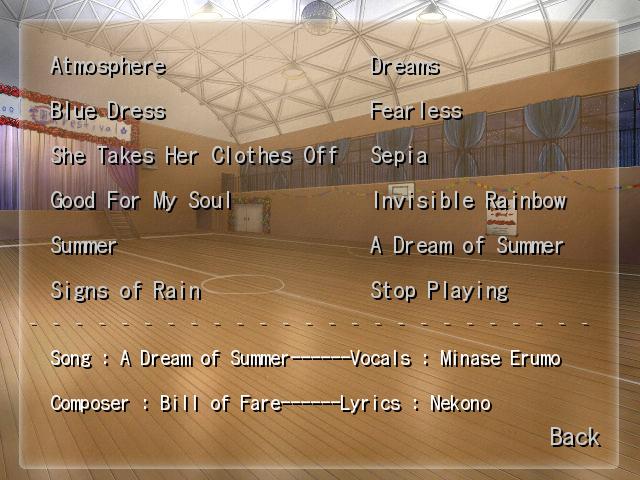
The other tracks are more typical background music for this type of novel, but they are solid. Bill of Fare’s Summer and Yoshihiro Ogawa’s Blue Dress are the standout background tracks.
Post-Completion
Completing both endings (or only Mizuna’s, I am not sure since I completed Shinoi’s first) unlocks an Extras menu with all previously-seen CG scenes, a music jukebox (see above), access to the mini-game, and the author’s afterword.
Translation quality
As always, I preface my translation assessment by noting that I do not know Japanese and thus have not read the original Japanese novel. My assessment covers only how well the English version reads and any obvious translation comments.
A Dream of Summer reads well and is generally free of jarring awkwardness. I suspect my issues with the script (to be discussed below) derive from the original Japanese rather than from DejaVu’s solid translation effort. There were some moments of awkwardness particularly in Shinoi’s distinct route where what Toshiki and Shinoi conversation about a specific dramatic event seemed a bit off – at least insofar as they discussed the ramifications of the event. But I have no reason to believe that this issue was particular to the translation rather than reflective of the underlying script that was being translated. The same could be said of some of Toshiki’s interactions with Reiji. Mizuna’s route is more intricate than Shinoi’s – albeit not the most intricate writing we have seen from the al|together novels. It fortunately reads much better than Shinoi’s route – with whatever shortcomings it has being clearly attributable to the source material.
Writing and story quality
A Dream of Summer’s script falls short of matching the overall quality of its strong production – albeit the extent to which it does so depends on which part of the story you assess.
A Dream of Summer began on the wrong foot with me because of the attitude of the view-point protagonist, Toshiki. It is important for visual novels that are seen entirely or almost entirely through a single perspective to write the point-of-view character well. Toshiki is often a difficult protagonist to like. He is dry, listless, and a bit blunt – the latter point earns him his “realist” moniker. This “realism” is contrasted with his fixation on a childhood promise he made to a girl whose name he forgot. My main issue with him is his attitude. When he first meets Mizuna, Toshiki quickly takes to teasing her – but the teasing carries with it an unpleasant edge that is jarring because he only just met the girl (Mizuna gets her own jabs in but does not give as good as she gets) and that is later still jarring when Toshiki’s feelings toward Mizuna undergo a sharp – albeit admittedly accounted for – evolution.
I contrast Toshiki’s teasing of Mizuna early on with some of his limited reactions with Mami Kagawa . Toshiki and Kagawa engage in some banter, but it is clear that they know each other, and this fact removes much of the edge I saw in Toshiki’s interactions with Mizuna. There is no well-explained reason for Toshiki to be as edgy as he is.

To be sure, Toshiki’s personality faults are not uncommon in male visual novel point of view characters. But I think they are worse in A Dream of Summer than in most cases because of the particularities of his relationship to Mizuna. For example, I lodged similar complaints against the protagonist of milkcat’s prior visual novel effort, At Summer’s End. However, in that case, the protagonist was in middle school, and he had been best friends with the girl he bantered with for almost his entire life. Toshiki, is is soon to graduate from high school, yet he takes to lowbrow teasing of Mizuna the moment he meets her. Moreover, the protagonist of At Summer’s End was coming to terms with his changing feelings for his best friend in a simple, very quaint, coming of age story. In contrast, A Dream of Summer has a more complicated set-up for Toshiki and Mizuna, and it walks a thin line in trying to make Toshiki’s developing sentiments for her credible . Perhaps the best analogue for my Toshiki complaints is the high school protagonist of A Winter’s Tale, who was also abrasive toward his best friend and potential romantic interest, but that too featured two characters who had been best friends their entire lives in a much simpler story about evolving feelings.
Toshiki’s attitude does improve as the novel goes on, and the sentimentality at the end of both Mizuna’s and Shinoi’s routes is delivered with some force (albeit see caveats further down). Nevertheless, much of the second half entails his partial recovery from a generally poor first impression.
As I noted very early in the article, while A Dream of Summer does not reveal its hand to Toshiki until the mid-game, most readers should be able to figure out where things are going with respect to Toshiki’s past and Mizuna’s entrance very early in the story. This, I think, is largely by design – A Dream of Summer has no ambition to be a mystery. But it is nevertheless interesting how it lays all of the clues front and center from its earliest scenes.
A Dream of Summer branches into two separate routes after the mid-game (assuming the player does not accidentally fail to trigger one): Mizuna and Shinoi. It is not uncommon for multi-path novels to have one path that is significantly stronger than the other. For example, another al|together 2006 entry, Flood of Tears, has a similar set-up with branching paths corresponding to two girls, with one path (Hina) being significantly stronger than the other (Umi). However, in the case of Flood of Tears, which is structurally similar (and even somewhat thematically similar), Hina and Umi were established early on as characters of similar importance – and although I think Hina’s character and route were stronger, one could argue that Umi’s was slightly more instructive regarding some of the novel’s underlying currents.
In A Dream of Summer, there is no balance in significance between the characters with routes. Mizuna is clearly the most important character from the moment she is introduced, and there is no question after playing both routes that her end is the true end (it is the only ending that triggers the end credits). One could be forgiven for being surprised after Shinoi’s meek introduction to learn that she has a route. One could be forgiven after completing Shinoi’s route for asking why she had a route.
(Note: I triggered Shinoi’s route first while playing blind and I suspect that most readers are more likely to land on Shinoi’s route in the first instance. – This is probably the best order from the perspective of someone who wants to read the entire novel since Mizuna’s route is the true ending.)
To be clear, Shinoi is inoffensive – but she has no characterization beyond being small, shy, and meek. There is no indication that she had much of a pre-existing relationship with Toshiki prior to the events of the story. Although the novel does give the route a set-up, one will struggle to find any sort of natural chemistry or reason for them to spend time together even after reading through the whole thing. That is – even more than Shinoi never breaking free of the small meek shy girl archetype – the fundamental problem with her route: it feels unnatural. In some ways it is similar to my complaint about the proverbial meek shy girl route in a Canadian visual novel called ACE Academy – it was forced. I noted in the translation section that there were a few points of dialogue – especially surrounding the dramatic event which triggers Shinoi’s route – which read unnaturally. I suspect some of this betrayed the fact that the writers themselves were not quite sure what to do with Shinoi.
Mizuna’s route is the highlight of A Dream of Summer and solid on its own terms, but a bit disappointing when one considers what it could have been with a more deft touch. I am constrained in what I can say about Mizuna’s route for spoiler concerns – even granting that the spoilers are front and center before even reaching her route. In contrast to Shinoi, the story provides a reason for Toshiki and Mizuna to have a route and grow closer to each other over the four days of events surrounding their school festival. While I think Toshiki’s attitude toward Mizuna is unpleasantly abrasive early on, he loses enough of his edge as they spend time together that they make for much better conversation than he does with Shinoi. The true end – that is the finale of Mizuna’s route – was set up well and delivered with sufficiently strong feeling for what A Dream of Summer wanted to accomplish. There is an interesting point to the ending of Mizuna’s story which occupies about half of the developer’s afterword (the half not occupied by the mini-game) wherein the developer offers specific reasoning for the writing choices (I think the developer made the correct decision). I will specifically credit the developer for coming up with a surprisingly endearing explanation for setting up the Mizuna-Toshiki meeting, albeit I cannot discuss it in detail in a generally spoiler-free review.
However, having granted that Mizuna’s route is the highlight of A Dream of Summer, it too underachieved. The set-up for Mizuna’s route was too convenient – primarily on Toshiki’s side – and not developed with enough attention to detail to make the depth of Toshiki’s sentiments and feelings entirely believable. That lack of attention to detail relegates what could have been an interesting lead-in to the time Toshiki and Mizuna share at the cultural festival into a bit of cliche. Regarding Mizuna, the novel broached an interesting inhibition that Mizuna had at the high school prior to the present events of the novel, but then failed to follow through on developing it. The lack of careful and proper development did not render Toshiki’s and Mizuna’s story entirely ineffective, but it made the sentimental emotional payoff feel less earned than it should have.
While I did not much like A Dream of Summer’s vaunted mini-game, it did have some solid moments of comedy. I appreciated its early vending machine skit (which turned into an amusing running gag), and Toshiki’s interactions with Reiji were consistently funny. Toshiki has some good scenes with Mizuna when he loses some of his early surliness.
Final Assessment
A Dream of Summer is frustrating not because it is bad – as a complete package it is a decent al|together effort – but because it ultimately wastes much of its potential. For example, milkcat’s earlier novel, At Summer’s End, was relatively solid for what it was but also very unambitious – it set out to tell a very simple story and stuck to that script for what turned out to be a solid, albeit uninspiring, project. I would have handled the event leading to the conclusion of At Summer’s End slightly differently , but it is hard to find much that one could change about it to move the needle one way or another.
A Dream of Summer was significantly more ambitious than its milkcat-developed predecessor, and had it been written more deliberately resulting in a better script, its strong production values would have made it one of the very best al|together entries instead of a middle-of-the-pack piece. The developer showed the ability to sell emotional scenes with a punch, but not the ability to ensure that they felt fully earned. I found myself often thinking about how some scene should have gone slightly differently or been given a better foundation. Similarly to Eno Yamamoto Ten’s Plain Song and Poor Little Bird (both translated for al|together 2005), A Dream of Summer, along with feels like it was a few changes away from being excellent. Dropping Shinoi’s route, giving Toshiki’s long-held feelings a stronger foundation, and better developing Mizuna’s story from prior to the events of the game could have made A Dream of Summer a memorable piece.
On the whole, A Dream of Summer is well-worth reading for people interested in NScripter novels (and translations of thereof) from the era, primarily for its excellent audio-visual production values for a freeware project. For those without this specific interest, I offer a qualified recommendation similar to that which I gave milkcat’s At Summer’s End. A Dream of Summer has a distinctly high school setting. Mizuna’s route, granting its insufficient foundation and failure to explore some ideas it introduced, is solid and a generally good read once it is triggered. Shinoi’s route can safely be skipped, although its worst fault is being somewhat aimless.
